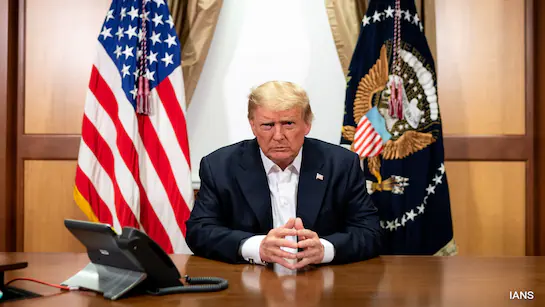
U.S. President Donald Trump Urges India to Purchase More American Weapons because , During his presidency, Donald Trump actively sought to strengthen U.S.-India defense relations by encouraging India to purchase more American-made weapons. As part of his “America First” agenda, Trump aimed to boost U.S. arms exports while supporting India’s military modernization goals. The move was seen as a way to counterbalance growing regional tensions in Asia, particularly with China and Pakistan.
India, being one of the largest arms importers in the world, has been a key focus for U.S. defense manufacturers. By urging India to increase its procurement of American weapons, Trump aimed to not only deepen the strategic partnership between the two nations but also create economic opportunities for the U.S. defense industry. This initiative highlighted the growing importance of defense cooperation in U.S.-India relations.
5 Powerful Reasons Trump Pushed India to Buy More U.S. Weapons
1. Strengthening U.S.-India Defense Ties
Donald Trump’s push for India to buy more American weapons was part of a broader strategy to enhance defense ties between the two nations. By fostering a closer military partnership, the U.S. aimed to strengthen India’s position as a regional power and a counterweight to China’s growing influence. The sale of advanced weapons systems like fighter jets, drones, and missile defense systems was designed to boost India’s military capabilities while solidifying the U.S.-India strategic relationship.
In addition to addressing India’s defense needs, this move also served U.S. interests by creating a reliable ally in South Asia. The partnership showcased the shared goal of maintaining peace and stability in the Indo-Pacific region, emphasizing the importance of mutual defense collaboration in addressing common security challenges.
2. Boosting the U.S. Defense Industry
One of Trump’s key motivations for encouraging India to purchase more American weapons was to boost the U.S. defense industry. By expanding arms sales to India, Trump sought to create jobs, support manufacturing, and enhance the competitiveness of American defense companies in the global market. Major U.S. defense contractors, such as Lockheed Martin, Boeing, and Raytheon, stood to benefit significantly from increased Indian procurement.
For India, purchasing U.S. weapons offered access to cutting-edge technology and advanced defense systems, which could enhance its military readiness. For the U.S., it was an opportunity to increase its market share in one of the world’s largest defense markets, furthering Trump’s economic agenda while strengthening bilateral ties.
3. India’s Modernization Goals
India has long sought to modernize its defense forces to address evolving security threats, particularly from neighboring countries like China and Pakistan. U.S. President Donald Trump Urges India to Purchase More American Weapons encouragement to buy American weapons aligned with India’s military modernization objectives. The U.S. offered state-of-the-art technology, such as the F-21 fighter jets and advanced surveillance systems, which could provide a significant upgrade to India’s defense arsenal.
However, India’s push for self-reliance in defense manufacturing posed a challenge. While the U.S. sought to sell more weapons, India was simultaneously striving to develop indigenous capabilities under its “Make in India” initiative. This dynamic created a complex balancing act between strengthening partnerships with foreign suppliers and building domestic production capacity.
4. Strategic Counterbalance in Asia
U.S. President Donald Trump Urges India to Purchase More American Weapons. 5 Compelling Reasons Trump Pushed India to Buy More U.S. Weapons Trump’s proposal to sell more weapons to India also had a geopolitical dimension. With growing tensions between India and China, particularly after border clashes in the Himalayas, the U.S. saw an opportunity to support India in countering Chinese aggression. The arms deals were part of a larger Indo-Pacific strategy, aimed at maintaining regional stability and countering China’s assertiveness.
Additionally, India’s strained relations with Pakistan, coupled with frequent cross-border skirmishes, made strengthening its defense capabilities a priority. By offering advanced American weapons, the U.S. positioned itself as a reliable defense partner, aligning with India’s strategic goals while advancing its own regional interests.
5. Challenges and Concerns
The geopolitical landscape in South Asia has always been a focal point for global powers, with the U.S. particularly interested in strengthening its influence in the region. U.S. President Donald Trump urged India to purchase more American weapons, viewing this move not just as a defense deal but as part of a broader strategy to maintain U.S. dominance in the region, especially as China’s presence and power continue to grow. By selling advanced weapons to India, the U.S. sought to create a counterbalance to China’s military expansion and bolster its own strategic position.
The U.S. also viewed India as an essential partner in maintaining regional security and stability, especially amid rising tensions with Pakistan and territorial disputes in the South China Sea. Through defense cooperation, U.S. President Donald Trump urged India to purchase more American weapons, aiming to create a more stable security environment in South Asia while ensuring its interests in the region were safeguarded. This geopolitical strategy highlighted the role of military partnerships in influencing international diplomacy and global power plays.
6. Evolving U.S.-India Strategic Partnership
The U.S. and India’s defense cooperation has evolved significantly in recent years, with both nations aligning on key security issues in the Indo-Pacific region. U.S. President Donald Trump urged India to purchase more American weapons as part of his broader strategy to deepen this strategic partnership. The two countries began sharing more intelligence, conducting joint military exercises, and collaborating on counterterrorism efforts. U.S. arms sales were seen as a way to cement India’s role as a key partner in this growing alliance. The evolving relationship marked a shift in global power dynamics, with the U.S. aiming to bolster India’s regional standing while countering the influence of other powers, notably China and Russia.
This strategic partnership also saw agreements on technology sharing and defense manufacturing, paving the way for closer military and economic ties. While both nations recognized the need for such collaboration, the balance between defense procurement from the U.S. and domestic military production in India remained an ongoing challenge.
7. Geopolitical Dynamics and U.S. Interests in South Asia
The geopolitical landscape in South Asia has always been a focal point for global powers, with the U.S. particularly interested in strengthening its influence in the region. U.S. President Donald Trump urged India to purchase more American weapons, viewing this move not just as a defense deal but as part of a broader strategy to maintain U.S. dominance in the region, especially as China’s presence and power continue to grow. By selling advanced weapons to India, the U.S. sought to create a counterbalance to China’s military expansion and bolster its own strategic position.
The U.S. also viewed India as an essential partner in maintaining regional security and stability, especially amid rising tensions with Pakistan and territorial disputes in the South China Sea. Through defense cooperation, U.S. President Donald Trump urged India to purchase more American weapons, aiming to create a more stable security environment in South Asia while ensuring its interests in the region were safeguarded. This geopolitical strategy highlighted the role of military partnerships in influencing international diplomacy and global power plays.
Buy Domin and Hosting with our trusted websites
https://www.hostinger.in/
https://www.bluehost.com/




Leave a Reply